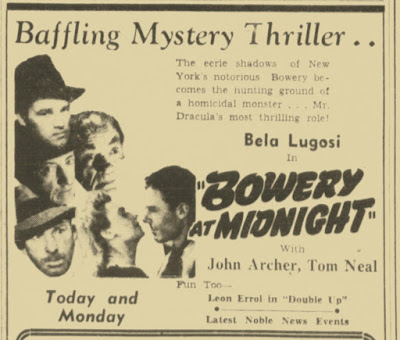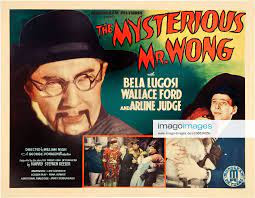This Mexican film, The Monstrous Dr. Crimen, set in the Balkans in the 1950s, is an interesting combination of the original 1925 Phantom of The Opera with Lon Chaney, Frankenstein (1931) with Boris Karloff and House of Wax (1953) with Vincent Price. The film was made the same year as House of Wax in 1953 but not released until 1955. The film is also known as other titles of The Revived Monster, Monster and The Resurrected Monster.
Nora, played by Miroslava Stern, is a bored newspaper journalist looking for an exciting story to publish. She feels her newspaper has become too routine and passe for readers. She tells her editor, Mr. Gherasimos (Fernando Wagner) in a local cafe that her life has become boring and stupid. She wants some excitement in her life.
Gherasimos suggests to Nora that she respond to a lonely hearts classified advertisement in the newspaper of a wealthy man looking to meet a young woman. He feels this might be the opportunity she needs to write an exciting story. Nora accepts the editor's suggestion and meets a man dressed in a dark cape at a boat loading dock at 9 pm that evening. The man's face is covered in sunglasses and a black scarf as he approaches Nora. A white rose that Nora wears on her coat is quite the contrast to the man's dark appearance as she approaches him.
After establishing a trust in the dark dressed man, Nora agrees to return to his home to be put to a test. The couple drive to a cemetery. Nora becomes frightened at the dark and foggy cemetery. The dark man assures her that his house is just past the cemetery. He tells Nora that his house is where dead people live. The couple walk slowly through the cemetery.
Nora observes many life size wax figures of female models in the house, which further adds to her nervousness. All the mirrors in the house are covered. The dark dressed man reveals his name to be Herrmann Ling (Jose Maria Linares-Rivas) – a plastic surgeon who not only sculpts wax figures but also conducts experiments in his basement laboratory. Ling plays the piano for Nora as a skull sits on top of the piano. Ling's assistant Mischa (Alberto Mariscal) tells Nora that Herrmann Ling creates wax figures for nothing more than a hobby.
Nora becomes anxious to see Ling's face, but he fears her rejection. Ling claims he hides behind his disguise because of the hatred and rejection of mankind towards him. He removes the sunglasses and scarf from his face as Nora faints. His face is elongated and distorted with deep scars. Nora insists that she is not frightened by his appearance, and kisses Ling. This causes Ling to be so happy with joy that he removes all the coverings of the mirrors in the mansion.
The next day, Nora reports to Gerasimos in the cafe about her meeting with Herrmann Ling. Ling is hiding nearby behind a partition in the cafe and listening to their conversation. He feels betrayed by Nora reporting their meeting to Gerasimos. This causes Ling to be angry with rage, so he revives a corpse of a handsome young man in his laboratory to meet with Nora so that he can have her murdered.
The cemetery sequences in this film are every bit as creepy and atmospheric as any seen in classic Universal Studios monster movies from the 1930s and 40s. The Monstrous Dr. Crimen is often said to be the film that laid the foundation for many other south-of-the border Mexican horror films that followed in the 1950s. The mask unveiling scene does not pack the same punch as the unmasking scene of Lon Chaney in The Phantom of The Opera (1925), but it still sends chills up the viewer's spine. Ling's grotesque face repels the viewer with fright.
Sinister Cinema in Medford, Oregon sells The Monstrous Dr. Crimen on their Drive-In Double Feature #156 with Daughter of Horror (1955 – AKA Dementia). The Drive-In Double Feature DVD contains trailers and classic drive-in movie intermission clips between the two films. This drive-in double feature is a great treasure to have for any fan of rare, obscure horror films. Happy Viewing.




.jpeg)



.jpeg)




